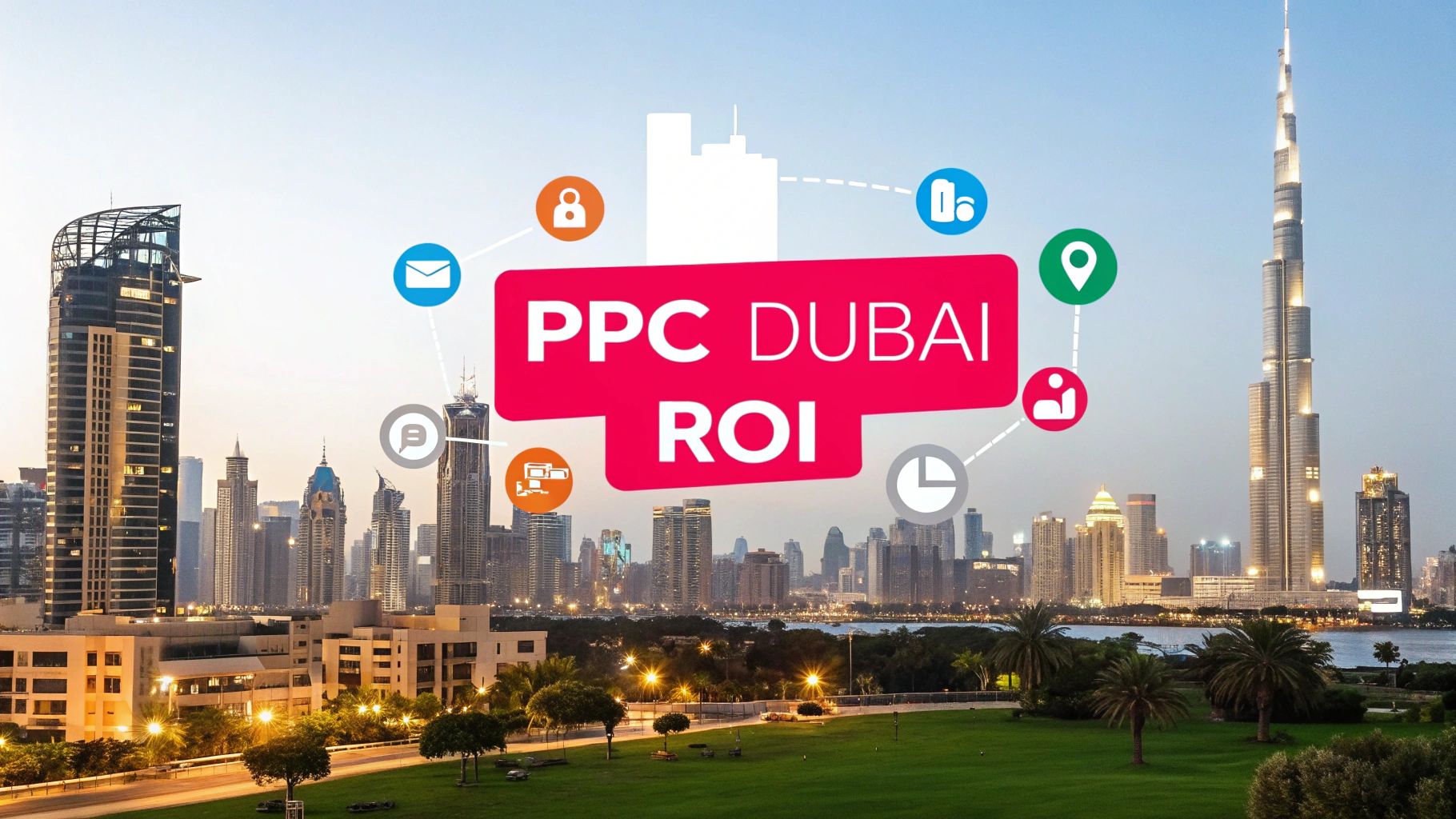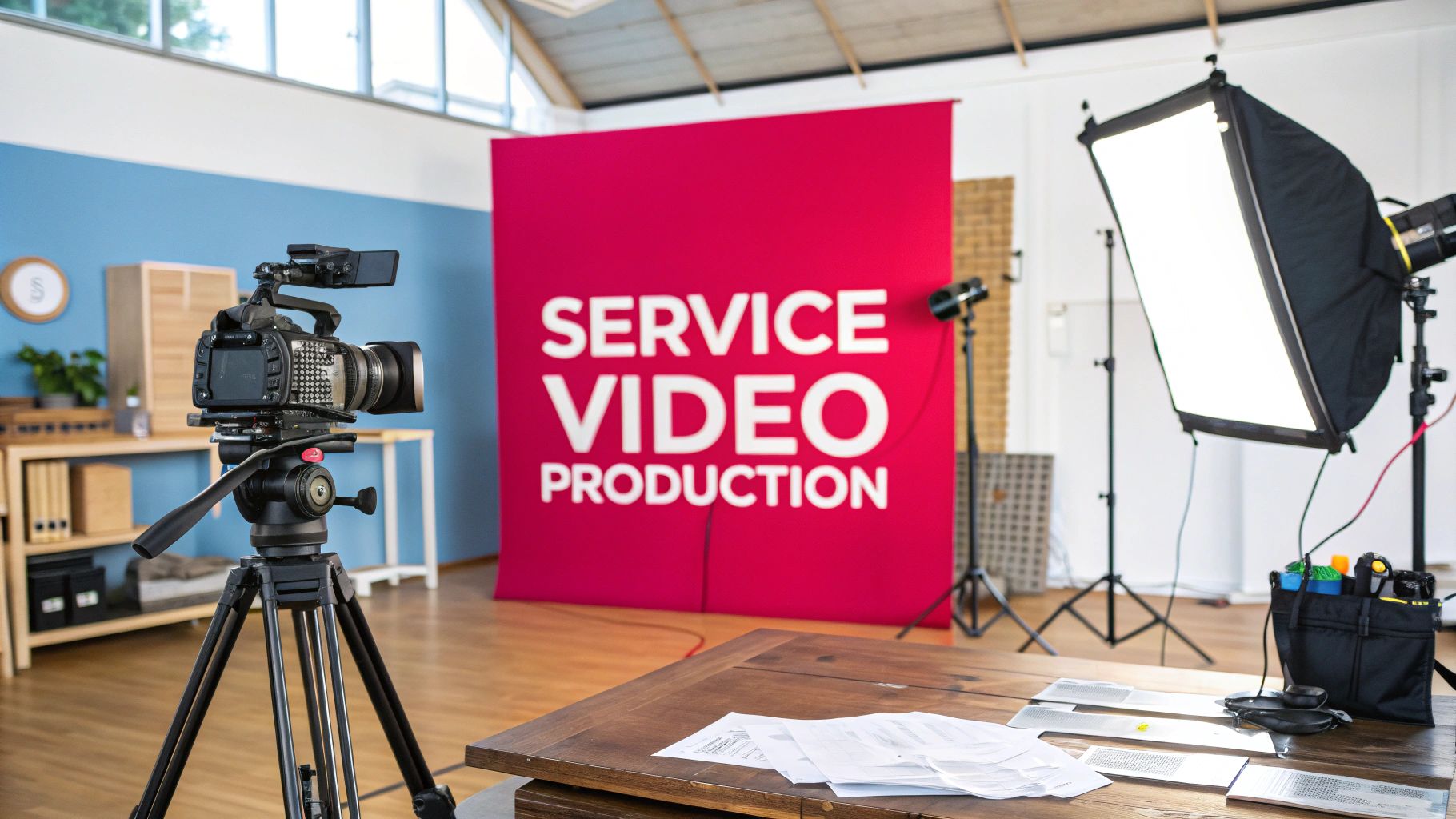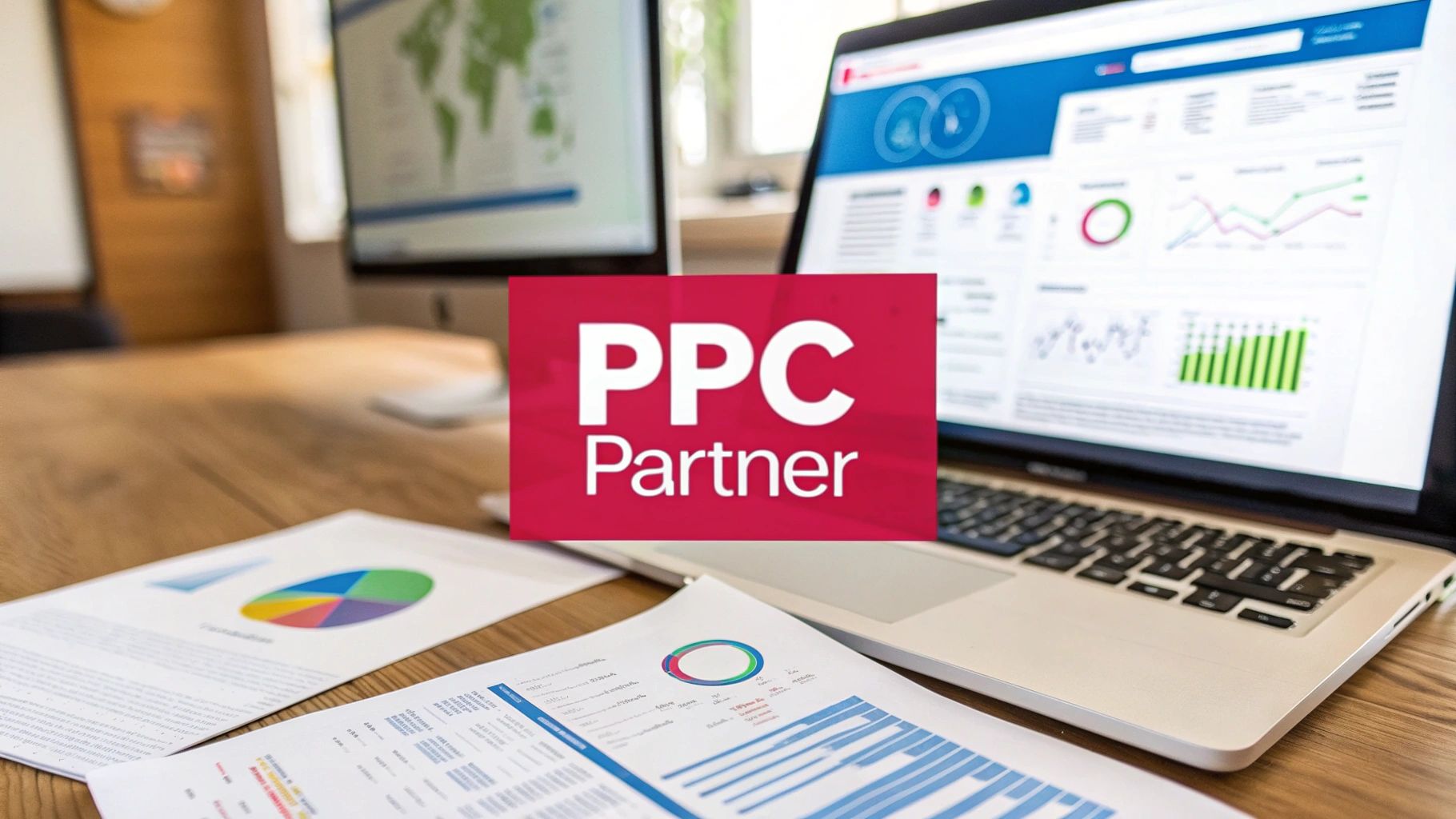A solid content marketing strategy isn't just about creating content; it's the blueprint that ensures every article, video, and social post you publish is working toward a specific, measurable business goal. Think of it as the difference between throwing spaghetti at the wall and building a predictable engine for growth. It’s what helps you attract the right people and guide them where you want them to go.
Building Your Content Strategy Foundation

Before you ever write a headline or hit record on a camera, you have to get crystal clear on your "why." A powerful strategy is always built on a solid understanding of what you’re trying to achieve. Without that clarity, your efforts will feel random, you won't be able to measure what's working, and you’ll end up wasting time and money.
This planning phase is all about setting the rules of the game. It gets everyone on the same page, from your writers to your social media team, creating a seamless brand experience that your audience will notice.
Define Your Core Business Objectives
What does success actually look like for your business? Your content needs a job to do. Vague goals like "get more traffic" just won't cut it. You need to focus on tangible outcomes that move the needle.
Your primary goals might include:
- Generating Qualified Leads: Filling your sales pipeline with prospects who are a great fit for what you offer.
- Building Brand Authority: Becoming the trusted, go-to expert in your niche.
- Improving Customer Retention: Creating content that helps current customers succeed, boosting loyalty and lifetime value.
- Driving E-commerce Sales: Using content to guide people from discovering your product to clicking "buy now."
Let’s make this real. A B2B software company might be laser-focused on generating qualified leads. Their strategy would probably lean heavily on in-depth case studies, expert webinars, and detailed guides that solve big problems for their ideal customers. On the flip side, a direct-to-consumer skincare brand might prioritize building authority and driving sales through educational blog posts and user-generated content on Instagram.
Key Insight: A well-defined objective is your North Star. When you're debating a new content idea, just ask yourself: "Does this directly help us achieve our primary goal?" If the answer isn't a clear "yes," it’s probably not the best use of your resources.
Develop a Clear Mission Statement
Once you know your goals, it's time to craft a content mission statement. This is a simple, internal declaration that sums up who your audience is, what you'll create for them, and how it will benefit them. It’s the guidepost that keeps your entire team aligned.
A great mission statement provides incredible focus. For example, a financial advisor targeting young professionals could have a mission like this: "To provide millennials with actionable, jargon-free financial advice through our blog and podcast, helping them build wealth confidently."
This statement instantly defines the audience (millennials), the content (actionable advice), the channels (blog, podcast), and the value to the reader (building wealth confidently). It’s your best defense against "content drift"—that slow slide into creating stuff that’s off-brand and off-mission.
Before we dive deeper, it's essential to have a clear, high-level view of these foundational elements. A well-structured plan is built on several core components working in harmony.
Core Components of a Content Strategy Foundation
| Component | Objective | Key Question to Answer |
|---|---|---|
| Business Goals | To connect content efforts to tangible business outcomes. | What do we need our content to do for the business? |
| Target Audience | To create content that resonates deeply with the right people. | Who are we trying to reach and what do they care about? |
| Mission Statement | To maintain focus and consistency across all content. | What are we creating, for whom, and what is the benefit? |
| Key Topics/Pillars | To establish expertise and own specific areas of conversation. | What core subjects will we be the authority on? |
| Channels & Formats | To meet our audience where they are with the right content type. | Where does our audience hang out and how do they like to consume content? |
Having these components locked down ensures that every decision you make—from a blog post topic to a video script—is strategic and purposeful.
This strategic shift isn't happening in a vacuum. The trend is global. For instance, approximately 70% of marketers in the MENA region now make content marketing a central part of their digital advertising, showing a massive move toward digital-first thinking. This push is fueling demand for more engaging formats and localized storytelling, especially in places like the UAE.
A strong content plan is a critical piece of your overall marketing puzzle. To see how it all fits together, you can learn more about how to create a digital marketing strategy in our comprehensive guide.
Mastering Audience and Keyword Research
Any powerful content marketing strategy really boils down to one thing: a deep, almost intuitive understanding of what your audience is actually looking for. Forget just plugging terms into a keyword tool. That's entry-level stuff. The real magic happens when you build a content plan that isn't just driven by data, but is genuinely connected to your audience's world.
This means you need to map out their entire journey. What questions are they asking when they first realize they have a problem? What are they thinking about when they’re ready to pull the trigger and buy? Your goal is to be the answer they find at every single one of those moments.
Uncovering Your Audience's Intent
People don't just search for keywords; they search for answers and solutions. Your first job is to get inside their heads and decode the search intent behind every query. Are they just trying to learn something? Are they weighing their options? Or do they have their credit card out, ready to go?
Think about it. Someone searching for "best running shoes" is in a completely different frame of mind than someone searching for "Nike Pegasus price in Dubai." The first query is informational, while the second is clearly transactional. Your content has to match that specific intent to be effective.
So, how do you figure this out? Start by listening. Seriously. Dive into the online communities where your audience hangs out—think Reddit threads, niche Facebook groups, or industry-specific forums. What questions come up over and over again? What are their biggest frustrations? This is where you'll find raw, unfiltered insights into their problems. To dig even deeper, you should explore these top audience research methods for some truly game-changing insights.
Finding High-Value Keywords
Once you’re fluent in your audience's language, you can start pinpointing the keywords that will actually bring them to your site. High-volume keywords are tempting, I get it, but the real gold is almost always in long-tail keywords. These are the longer, more specific phrases that signal someone is much further along in their journey.
A search for "content marketing" is broad; they're probably just browsing. But a search for "content marketing strategy for B2B tech startups" tells you that person knows exactly what they need. That specificity means less competition for you and a much more qualified visitor landing on your page.
Pro Tip: Spend some quality time with Google's "People Also Ask" (PAA) section. Type in one of your core keywords and just look at the questions that pop up. Google is literally handing you a list of what users are curious about. It’s a ready-made list of relevant topics you should be covering.
Analyzing Competitors to Find Gaps
Your competitors are a treasure trove of data, so use them. Analyzing what they’re ranking for—and, just as importantly, what they aren't—is how you carve out your own space.
Fire up an SEO tool and see which keywords are sending the most traffic their way. I always look for topics where their content is a bit thin, outdated, or just doesn't quite nail the answer to the user's question. That’s your opening. It's your chance to create something far more comprehensive and valuable that can blow their content out of the water.
- Content Gap Analysis: Find the keywords your competitors rank for that you don’t even have on your radar yet.
- Quality Gap Analysis: Identify topics they cover, but that you could do so much better. Think more depth, fresher data, or a unique angle they completely missed.
This visual shows how to connect your big-picture business goals to a structured research plan.
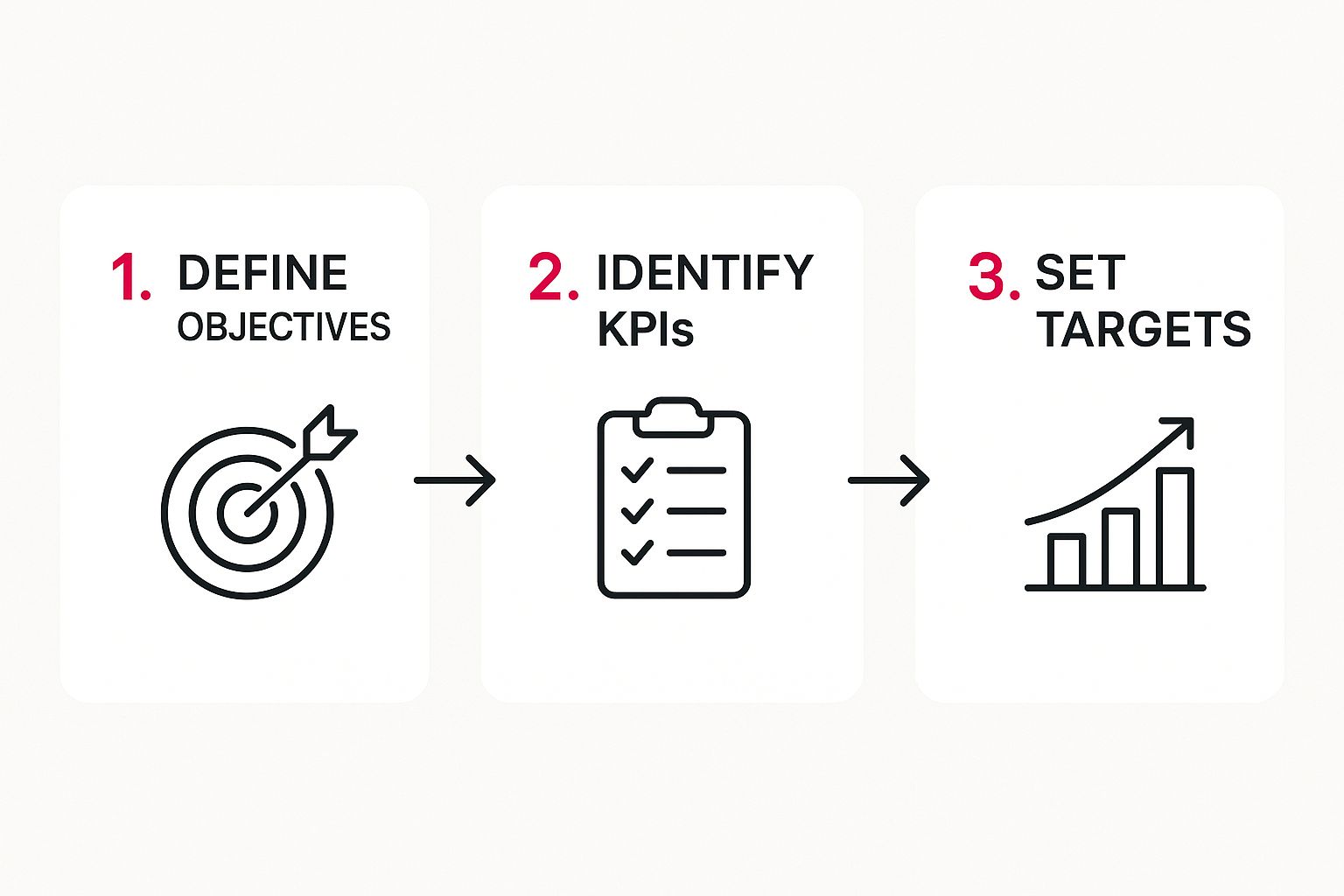
Following this process ensures your research always ties back to real business outcomes, taking you from broad objectives to specific, trackable targets.
Organizing Research Into Content Hubs
Whatever you do, don't just create a bunch of random blog posts. You need to organize your research and keywords into topic clusters. This is a powerful SEO strategy where you create a central, authoritative "pillar page" on a broad topic. Then, you support it with several "cluster pages" that explore related, more specific subtopics in detail.
For example, your pillar page might be "The Ultimate Guide to Social Media Marketing." Your cluster content would then be individual articles like "Instagram Marketing for E-commerce," "LinkedIn for B2B Lead Generation," and "How to Create a Facebook Ads Budget." This structure does two things brilliantly: it signals your authority to search engines, boosting your rankings, and it provides incredible, organized value to your readers.
Creating Content That Actually Connects

Alright, you’ve done the research and laid out your goals. Now for the fun part—turning all that planning into content that people actually want to read, watch, and share. This isn't about just checking boxes on a content calendar. It’s about crafting pieces that solve real problems, build genuine trust, and make your brand the one they remember.
A truly great piece of content does more than just chase a keyword. It makes a human connection and leaves your audience feeling seen and understood. This is your chance to transform raw data and customer insights into compelling stories and resources that showcase what makes your brand different.
Choosing the Right Content Format
Your message will only hit home if it’s delivered in the right package. The format you choose needs to be a perfect match for both the topic itself and how your audience likes to consume information. A deep, technical breakdown might call for a comprehensive blog post, while a quick, actionable tip is tailor-made for a short video.
Here are a few powerful formats I’ve seen work wonders:
- Deep-Dive Blog Posts: These are the workhorses of any solid content strategy. Think ultimate guides, detailed tutorials, and original research that cement your authority and pull in valuable long-tail keyword traffic.
- Compelling Case Studies: There's no better trust-builder than proof. Case studies are incredibly effective for prospects who are close to making a decision, as they show exactly how you solved a problem for a real customer.
- Engaging Videos: Whether it's a quick explainer for social media or an in-depth product demo on YouTube, video is a fantastic tool for grabbing attention and making complex ideas easy to digest.
- Interactive Quizzes: Quizzes are brilliant for engagement and generating leads. They help your audience self-diagnose a problem, delivering personalized results while giving you incredibly valuable data in return.
The real secret is meeting your audience where they already are. For instance, if you're marketing in the UAE, you can't ignore the massive shift toward streaming and connected TV (CTV). YouTube penetration there is a staggering 94%, with 2.5 million adults watching on CTV devices. Smart marketers are responding by creating CTV-friendly video content and using AI for automatic dubbing and summaries to reach a diverse, multi-lingual market. You can explore more about these MENA marketing trends and predictions to stay ahead.
Developing a Consistent and Recognizable Brand Voice
How you say something is every bit as important as what you’re saying. Your brand voice is the distinct personality your content projects, and it absolutely must be consistent everywhere you show up. Are you the helpful, authoritative expert? Or are you witty, informal, and a bit playful?
Key Takeaway: A consistent brand voice builds familiarity and trust. When your audience can instantly recognize your content by its tone, you're no longer just another company—you're a trusted resource they know and like.
This consistency has to go beyond your blog. The tone you strike in an email newsletter, for example, should feel connected to the direct, personal style you use on social media. This is especially true for more immediate channels, which is why a well-defined voice is so critical when creating your WhatsApp marketing approach.
Building a Practical Content Workflow
Even the best ideas will fall through the cracks without a system to bring them to life. A solid content workflow is what separates organized, consistent output from pure chaos. It’s the engine that moves content smoothly from a spark of an idea to a published piece.
This really boils down to a few key operational elements:
- A Realistic Content Calendar: This is your command center. It maps out what gets published, where, and when, giving your team clarity and keeping everyone accountable.
- Clear Workflow Management: Define the exact stages every piece of content moves through—from drafting and design to review and final approval. When everyone knows their role, you avoid bottlenecks.
- A Robust Quality Control Process: Before anything goes live, it needs a final, meticulous check. This last step ensures every article, video, and post is error-free, on-brand, and meets your standards.
AI tools can be an incredible ally here, helping with everything from brainstorming topics to optimizing headlines. They can supercharge your team's efficiency, but always remember that the final product needs that human touch. It’s the empathy, creativity, and strategic insight that AI can't replicate that ultimately makes your content connect.
Getting Your Content Seen: A Smart Distribution Plan
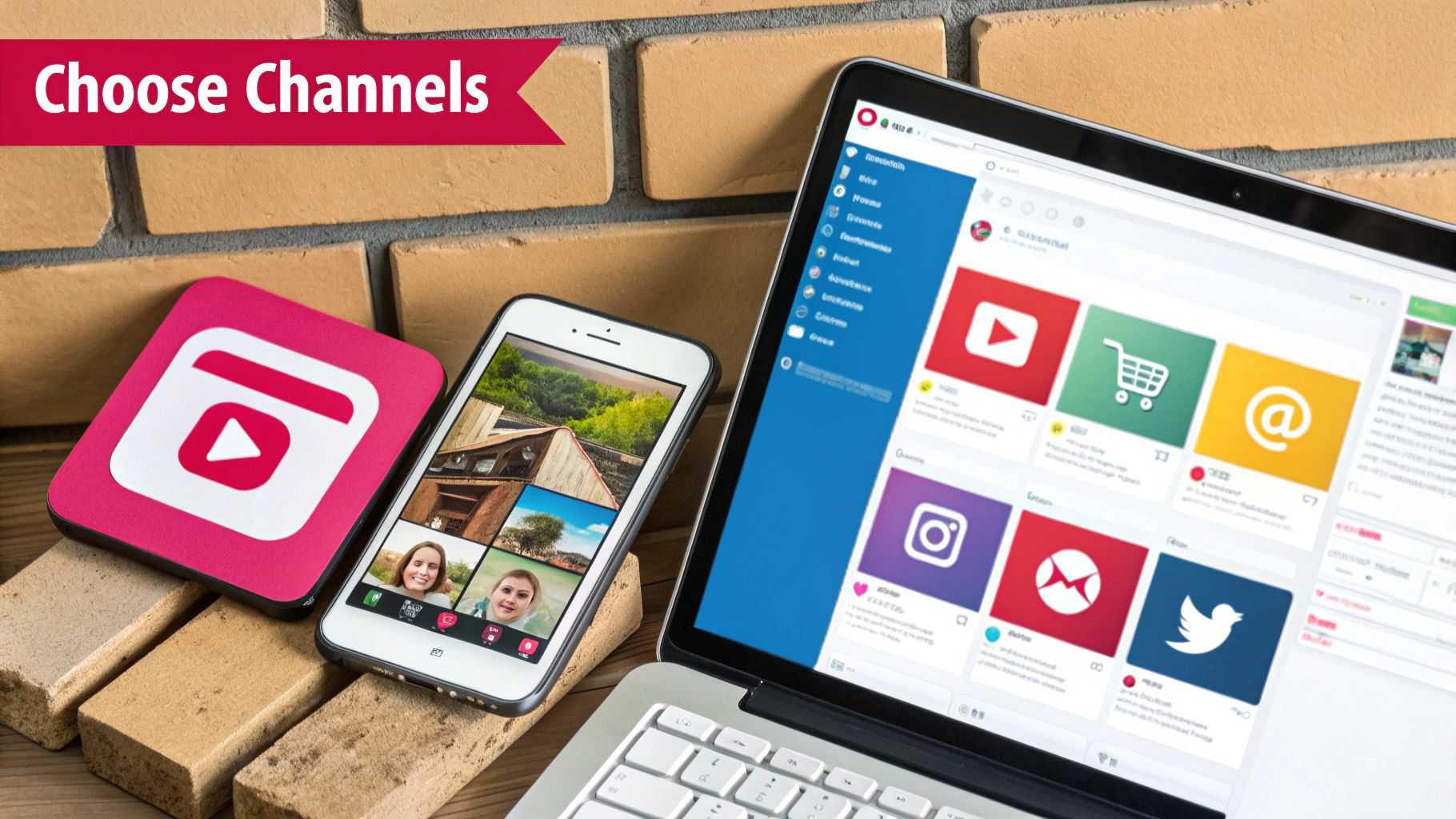
Let's be honest. Pouring your heart and soul into creating exceptional content is a huge win, but it’s only half the job. A brilliant article that nobody reads or a fantastic video that nobody watches doesn't help your business one bit. The real magic—and the real results—happen after you hit publish. A smart distribution plan is what turns your content from a file on a server into a powerful engine for growth.
This is about more than just tossing a link onto your social media feeds and hoping for the best. It's a calculated, multi-channel strategy designed to get your content in front of the right people, on the right platforms, at the right time. Think of it as building a network of superhighways all leading your ideal customer directly to you.
The Three Pillars of Content Distribution
A truly resilient distribution strategy doesn't put all its eggs in one basket. Instead, it balances efforts across three core types of media channels, creating a system that isn't dependent on a single source of traffic.
- Owned Channels: These are the platforms you own and control outright. We're talking about your company blog, your email newsletter, and your official social media profiles. These are your home turf, perfect for engaging the audience you've already worked hard to build.
- Earned Channels: This is the holy grail—free publicity you get when other people choose to share your work. Think organic press mentions, guest posts on respected industry blogs, genuine engagement in online communities, and good old-fashioned word-of-mouth. Earned media is incredibly powerful because it comes with built-in credibility.
- Paid Channels: This is where you put your money to work promoting your content. It includes everything from social media ads and search engine marketing (SEM) to sponsored content collaborations. Paid channels give you immediate reach and laser-focused targeting, helping you connect with a brand new, highly relevant audience almost instantly.
Imagine a B2B software company. They could use their blog and email list (owned) to share a new case study. Then, they could pitch guest articles to major tech publications (earned) that reference the study. Finally, they could run a targeted LinkedIn ad campaign (paid) to promote the case study to people with specific job titles. This integrated approach ensures their hard work reaches its maximum potential.
The Art of Repurposing: Work Smarter, Not Harder
One of the most powerful and efficient distribution tactics I've learned is to stop treating content like a one-and-done task. A single, comprehensive "pillar" article or video can be sliced and diced into dozens of smaller content assets, each one perfectly formatted for a different channel. This strategy dramatically extends the value and lifespan of your original effort.
My Two Cents: Don't just create content; atomize it. A single in-depth guide can become the fuel for your social media, email campaigns, and outreach for weeks on end. This is how you get the absolute maximum ROI from your creative energy.
Let’s say you created a massive guide to e-commerce marketing. You can easily repurpose it into:
- A series of quick, shareable tips for Twitter and Instagram.
- An infographic that visualizes the most compelling stats from the guide.
- A downloadable checklist or template to use as a lead magnet.
- A short script for a YouTube explainer video.
- Key talking points for a podcast interview or a webinar presentation.
This approach gets you off the content creation hamster wheel. You're no longer constantly scrambling for new ideas but are strategically amplifying your core message across every touchpoint your audience uses.
Build Relationships, Not Just Links
Your distribution strategy becomes exponentially more effective when you have allies in your corner. Proactively building genuine relationships with industry partners, influencers, and community managers can unlock access to audiences you could never reach on your own. This isn't about sending spammy "please share my post" emails.
It's about the long game. Provide value first. Comment thoughtfully on their content, share their work with your audience, and look for authentic ways to collaborate. When you finally do have an amazing piece of content that's a perfect fit for their audience, your request will come from a trusted peer, not a random stranger. A single share from a respected voice in your niche can often drive more high-quality traffic than a week's worth of your own promotional posts.
In today's market, strategic promotion is non-negotiable. In 2023, digital ad spending in the MENA region soared past $3.5 billion USD, driven by content-centric formats like video and social ads. With the average cost-per-click in the UAE sitting between $0.70 and $1.50, your promotion needs to be incredibly efficient to deliver a positive return. You can explore more data on MENA advertising trends on Statista.com to get a better feel for the landscape. This reality highlights the critical need for a distribution plan that blends organic reach with smart, targeted paid promotion.
Measuring Performance and Optimizing Your Strategy
Let's be honest: a content marketing strategy isn't a "set it and forget it" kind of deal. It's more like a living, breathing part of your business that needs constant attention. This is where the real work—and the real growth—happens. You have to constantly measure, analyze, and tweak. This feedback loop is what separates content that just sits there from a strategy that actually drives sustainable results.
It’s time to move past vanity metrics. Sure, seeing a spike in page views feels good, but does it actually help your business? We need to dig deeper into the numbers that matter. Is your content bringing in qualified leads? Are people sticking around to read what you've written, or are they hitting the back button after a few seconds? Answering these questions is how you start making smart, data-driven improvements.
Identifying Metrics That Truly Matter
First things first, you need to connect your analytics directly back to the business goals you set in the beginning. The metrics you track have to reflect what you "hired" your content to do. Throwing every possible metric onto a dashboard is a surefire way to get confused and lose focus.
For example, if your main objective is building brand awareness, you’ll want to keep an eye on things like:
- Social Media Reach and Shares: How many new people are seeing your content? More importantly, is it compelling enough for them to share it with their own networks?
- Brand Mentions: Are conversations about your brand popping up on social media or other blogs?
- Scroll Depth: This is a fantastic proxy for genuine interest. Are people reading your articles all the way through, or are they bailing after the first couple of paragraphs?
But if your goal is lead generation, your dashboard will look completely different. Your focus shifts to hard business numbers:
- Conversion Rate: What percentage of people who consume your content are taking that next step—filling out a form, downloading an ebook, or requesting a demo?
- Cost Per Lead (CPL): How much are you actually spending to get each new lead through your content?
- Lead Quality: This is a big one. It’s crucial to get feedback from your sales team. Are the leads you’re generating actually a good fit, or are they just kicking tires?
My Two Cents: Don't drown yourself in data. For each of your primary content goals, choose just 3-5 key performance indicators (KPIs). This keeps everyone on your team focused on the numbers that will actually guide your decisions, not just fill up a weekly report.
Building Your Performance Dashboard
Once you know what to track, you need a simple way to see it. A well-organized dashboard is your command center, and it doesn't need to be fancy or expensive. You can get a surprisingly powerful overview using Google Analytics 4 combined with the native analytics from your social media and email platforms.
The key is to structure your dashboard around your goals. Create a section for your awareness metrics and a separate one for lead generation. This simple organization makes it instantly clear what’s working and what isn’t, without you having to wade through a swamp of irrelevant data. Choosing what to monitor is the bedrock of a successful strategy, and you can explore this topic further in our detailed guide on picking the right marketing performance indicators.
The Power of the Content Audit
A regular content audit is easily one of the highest-impact things you can do. It’s a systematic review of everything you’ve published to figure out what to keep, what to update, and what to get rid of completely.
I suggest doing a light audit at least twice a year. Here’s a simple way to tackle it:
- Find the Underperformers: Look for posts with low traffic, dismal engagement, and zero conversions. These are your prime candidates for a major overhaul—or for deletion if the topic is just not relevant anymore.
- Spot Your Winners: Identify that top 5-10% of content that's driving the lion's share of your traffic, leads, or shares. These are your proven assets. Your job is to promote them more and brainstorm ways to repurpose them into new formats like videos or infographics.
- Update and Refresh: Some content is solid, it just needs a little TLC. Update old stats, add fresh examples, and give the on-page SEO a tune-up. Then, republish it. This is an incredibly effective way to get more mileage out of the work you've already done.
Of course, a critical piece of this optimization puzzle is effectively measuring content marketing ROI. This is how you justify your team's hard work and secure the budget you need to keep going.
Iterating with A/B Testing
The best content marketers I know are always testing. They don't guess what will work better—they find a way to prove it. A/B testing (or split testing) is just a straightforward way to compare two versions of something to see which one comes out on top.
You can A/B test almost anything, but here are a few easy wins:
- Headlines: Write two different headlines for your next blog post. See which one gets more clicks when you share it in your newsletter or on social media.
- Calls-to-Action (CTAs): Try different button copy, colors, or placements. Does "Get Your Free Template" work better than "Download Now"? The only way to know for sure is to test it.
- Content Formats: If a blog post on a certain topic does really well, would a video or an infographic on the same topic do even better? Test different formats across your channels to find out.
This cycle of measuring, auditing, and testing is what elevates a content strategy from good to great. It’s how you turn your content from a line item on a budget into a predictable and scalable engine for growing your business.
Your Content Marketing Questions, Answered
If you're diving into content marketing, you've probably got questions. It's a big topic, and it’s easy to get lost in the weeds. Let's tackle some of the most common questions I hear from businesses trying to get their strategy off the ground.
How Long Until I Actually See Results?
This is the big one, isn't it? The honest, no-fluff answer is: it takes time. Think of content marketing as planting a tree, not flipping a switch. You're building a long-term asset, which is a very different game from running a paid ad campaign that stops the second you turn it off.
For content that relies on SEO to bring in traffic, you're typically looking at a 3 to 6-month runway before you start seeing real, meaningful movement in Google's search results.
But that doesn't mean you're flying blind for half a year. You can spot early signs of life. A great piece of content, when you promote it smartly, can create a stir on social media, pull in new email subscribers, and even generate a few leads right out of the gate. The trick is to watch those early indicators—like shares and engagement—while the slower, more powerful SEO momentum builds in the background.
What Should I Realistically Budget for Content Marketing?
There’s no one-size-fits-all price tag here. Your budget really hinges on your goals, how competitive your industry is, and what skills you already have on your team.
A solid way to approach this is to think in percentages. Many businesses dedicate somewhere between 10% and 25% of their overall marketing budget to content.
So, where does that money go?
- Content Creation: This is the cost of paying talented people—writers, designers, video editors—to create the actual content.
- Essential Tools: You'll need software for SEO research like Ahrefs or Semrush, project management platforms, and analytics to track what's working.
- Promotion & Distribution: This is for putting some paid muscle behind your best work, like boosting a post on social media or running a sponsored content campaign.
The most critical shift in mindset is to see content as an investment, not an expense. When you consistently create valuable content, you're building an asset that your company owns and that will pay dividends for years to come.
I see so many businesses make the same mistake: they pour their entire budget into creating the content but leave nothing for promoting it. My rule of thumb? Earmark at least 20% of your content budget specifically for distribution. If you don't, you're just publishing into a void.
Should I Go for Quality or Quantity?
This debate comes up all the time, but today, the answer is crystal clear: quality is everything.
Years ago, you could churn out a high volume of thin, keyword-stuffed articles and see some results. That era is long gone. Search engines have gotten smarter, but more importantly, your audience has always been smart. They crave real value.
One comprehensive, well-researched article that genuinely helps your reader solve a problem is worth more than ten generic posts that just take up space. This is how you build trust. It’s how you earn valuable backlinks without asking. It's how you get people to remember your name and come back for more.
That isn't to say that quantity doesn't matter at all—consistency does. The goal is to find a rhythm you can stick to, where you're publishing excellent work without overwhelming your team. For many businesses, aiming for one or two truly outstanding pieces a month is far more effective than four mediocre ones a week. Don't just add to the noise; aim to be the definitive resource on a topic.
Ready to build a Grassroots Creative Agency that delivers real results? Our team specialises in creating data-driven strategies that connect with your audience and drive growth. Book a consultation with us today and let's start telling your brand's story.



